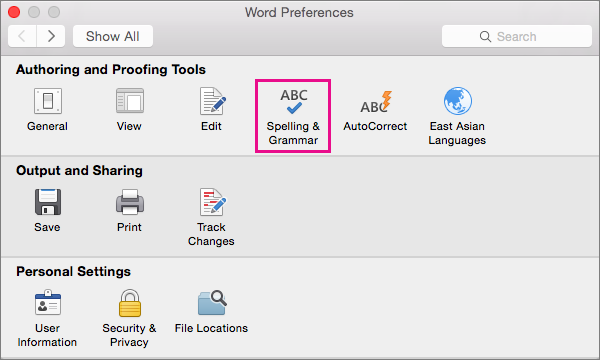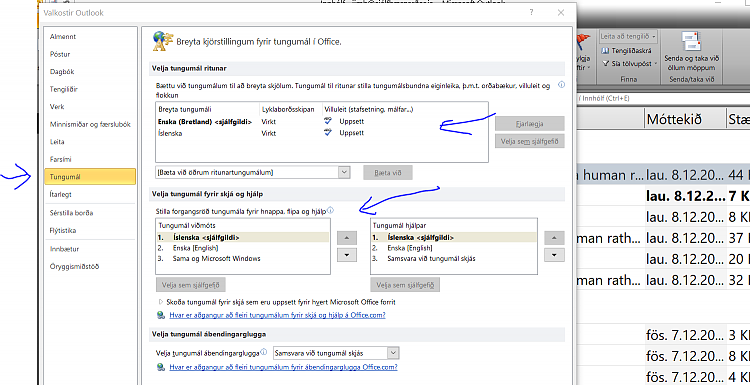Download the proper Language Accessory Pack for the language you want to use from this page: Language Accessory Pack for Office. The Language Accessory Pack contains the display and proofing tools for most languages, but you can still choose to have your display in one language and editing or authoring in another. Change Language Office 2016.
- This setting does not present itself when installing either, and there are no different installers per language. The only way to change the language that Office for Mac 2016 uses in it's menus and settings is by changing the OSX language. I want to change the language manually, so that it can be different from OSX's language.
- As a Technician I frequently install Office 2016 for my customers. Every time I need both English and Greek (or other language) interface, I have to go to the internet, download the web installer and then wait for the language pack to download and install.
- Click or tap where you're going to add text, or select the text that you want to mark as a different language. On the Review tab select Language Set Proofing Language. Select the language you want to.

Summary: Find language identifier and OptionState ID values for identifying and customizing Office 2016 language and proofing tools installations.

Use the values in the Language Identifier and OptionState ID tables to configure setup for Office 2016 or for Office proofing tools, or to identify currently installed languages.
This is a reference article. The values provided in the tables are necessary for completing procedures that are described in the following articles:
Important
This article describes methods of deploying and managing language packs for versions of Office 2016 that use the Windows Installer (MSI) installation technology, which are available for enterprises through volume licensing. If you have an Office subscription and you're deploying Microsoft 365 Apps, which uses the Click-to-Run installation technology, see Overview of deploying languages for Microsoft 365 Apps.
Language identifiers
Office 2016 Mac
Office 2016 is available in many languages. In an international setting, you can deploy multiple language versions of Office 2016 in a single installation process. Setup combines a language-neutral core product with one or more language-specific packages to create a complete product.
On the source media, language-specific packages are organized into separate folders. Each folder name has a language tag appended to it, in the form ll-cc. That tag identifies the language and culture. For example, U.S. English language folders are identified by the folder name extension en-us. The language tags help you determine the folders that you have to copy to the network installation point.
The language folders that are included in a fully localized version of an Office 2016 product are the same as the language folders that are included in the Microsoft Office 2016 Language Pack for a specific language. For example, the same Outlook.ar-sa folder is used in the Arabic language version of Office 2016, the Arabic language version of Outlook 2016, and the Office 2016 Language Pack - Arabic.
Note
Language tags are also referred to and used as 'language IDs' for some procedures.
Office 2016 offers localized versions in all the languages that are listed in the following table. Folders for the language-specific components are identified by the language tag that is shown in the table. The Windows operating system uses locale identifiers (LCIDs) to identify languages in the Windows registry.
In addition to the fully localized languages listed here, Office 2016 provides Language Interface Packs (LIPs), which contain a subset of language-specific components and are designed to be installed together with a logical parent language. Elements that are not localized in the LIP language appear in the parent language. For more information about LIPs, see Language Interface Packs.
Language tags (language IDs), and LCIDs available in Office 2016

| Language | Geographic area | Language tag (ll-CC)1 | LCID |
|---|---|---|---|
| Arabic | Saudi Arabia | ar-SA | 1025 |
| Bulgarian | Bulgaria | bg-BG | 1026 |
| Chinese (Simplified) | People's Republic of China | zh-CN | 2052 |
| Chinese | Taiwan | zh-TW | 1028 |
| Croatian | Croatia | hr-HR | 1050 |
| Czech | Czech Republic | cs-CZ | 1029 |
| Danish | Denmark | da-DK | 1030 |
| Dutch | Netherlands | nl-NL | 1043 |
| English | United States | en-US | 1033 |
| Estonian | Estonia | et-EE | 1061 |
| Finnish | Finland | fi-FI | 1035 |
| French | France | fr-FR | 1036 |
| German | Germany | de-DE | 1031 |
| Greek | Greece | el-GR | 1032 |
| Hebrew | Israel | he-IL | 1037 |
| Hindi | India | hi-IN | 1081 |
| Hungarian | Hungary | hu-HU | 1038 |
| Indonesian | Indonesia | id-ID | 1057 |
| Italian | Italy | it-IT | 1040 |
| Japanese | Japan | ja-JP | 1041 |
| Kazakh | Kazakhstan | kk-KZ | 1087 |
| Korean | Korea | ko-KR | 1042 |
| Latvian | Latvia | lv-LV | 1062 |
| Lithuanian | Lithuania | lt-LT | 1063 |
| Malay | Malaysia | ms-MY | 1086 |
| Norwegian (Bokmål) | Norway | nb-NO | 1044 |
| Polish | Poland | pl-PL | 1045 |
| Portuguese | Brazil | pt-BR | 1046 |
| Portuguese | Portugal | pt-PT | 2070 |
| Romanian | Romania | ro-RO | 1048 |
| Russian | Russia | ru-RU | 1049 |
| Serbian (Latin) | Serbia | sr-latn-RS | 2074 |
| Slovak | Slovakia | sk-SK | 1051 |
| Slovenian | Slovenia | sl-SI | 1060 |
| Spanish | Spain | es-ES | 3082 |
| Swedish | Sweden | sv-SE | 1053 |
| Thai | Thailand | th-TH | 1054 |
| Turkish | Turkey | tr-TR | 1055 |
| Ukrainian | Ukrainian | uk-UA | 1058 |
| Vietnamese | Vietnam | vi-VN | 1066 |
1 Language tag is sometimes referred to as the language ID.
Proofing Tools Config.xml OptionState Id values
The following table provides the OptionState ID values for the Office proofing tools. It is ordered alphabetically by language. Use these values to modify the Config.xml file in the ProofKit.WW folder when you customize the setup of the Office proofing tools. For more information about proofing tools, see Plan for Office proofing tools. For instructions on how to customize proofing tools, see Customize and install the Office proofing tools.
OptionState IDs for each Proofing Tools language in Office 2016
Download Office 2016 Mac
| OptionState ID | Proofing tools language |
|---|---|
| ProofingTools_1025 | Arabic |
| ProofingTools_1069 | Basque (Basque) |
| ProofingTools_1026 | Bulgarian |
| ProofingTools_1027 | Catalan |
| ProofingTools_2052 | Chinese (People's Republic of China) |
| ProofingTools_3076 | Chinese (Hong Kong) |
| ProofingTools_1028 | Chinese (Taiwan) |
| IMEMain_1028 | Chinese Traditional Input Method Editor (IME) |
| ProofingTools_1050 | Croatian |
| ProofingTools_1029 | Czech |
| ProofingTools_1030 | Danish |
| ProofingTools_1043 | Dutch |
| ProofingTools_1033 | English |
| ProofingTools_1061 | Estonian |
| ProofingTools_1035 | Finnish |
| ProofingTools_1036 | French |
| ProofingTools_1110 | Galician |
| ProofingTools_1031 | German |
| ProofingTools_1032 | Greek |
| ProofingTools_1095 | Gujarati |
| ProofingTools_1037 | Hebrew |
| ProofingTools_1081 | Hindi |
| ProofingTools_1038 | Hungarian |
| ProofingTools_1040 | Italian |
| ProofingTools_1041 | Japanese |
| IMEMain_1041 | Japanese IME |
| ProofingTools_1099 | Kannada |
| ProofingTools_1087 | Kazakh |
| ProofingTools_1042 | Korean |
| IMEMain_1042 | Korean IME |
| ProofingTools_1062 | Latvian |
| ProofingTools_1063 | Lithuanian |
| ProofingTools_1102 | Marathi |
| ProofingTools_1044 | Norwegian (Bokmål) |
| ProofingTools_2068 | Norwegian (Nynorsk) |
| IMEMain_2052 | Pinyin IME |
| ProofingTools_1045 | Polish |
| ProofingTools_1046 | Portuguese (Brazil) |
| ProofingTools_2070 | Portuguese (Portugal) |
| ProofingTools_1094 | Punjabi |
| ProofingTools_1048 | Romanian |
| ProofingTools_1049 | Russian |
| ProofingTools_2074 | Serbian (Latin) |
| ProofingTools_1051 | Slovak |
| ProofingTools_1060 | Slovenian |
| ProofingTools_3082 | Spanish |
| ProofingTools_1053 | Swedish |
| ProofingTools_1097 | Tamil |
| ProofingTools_1098 | Telugu |
| ProofingTools_1054 | Thai |
| ProofingTools_1055 | Turkish |
| ProofingTools_1058 | Ukrainian |
| ProofingTools_1056 | Urdu |
Related topics

Comments are closed.